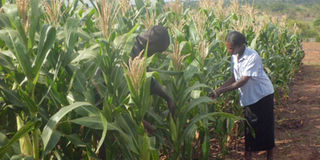Explaining genes and biotechnology

GM maize being tested for drought tolerance at a field trial. PHOTO BY LOMINDA AFEDRARU
For thousands of years, farmers, herdsmen and poultry keepers have been selectively breeding their crops and livestock to improve them by highlighting desirable traits or maintaining certain genes.
It was somehow a trial and error process since little was known about the mechanisms governing inheritance. But with expansion of scientific investigation over time, there was increased knowledge about cell division and sexual reproduction as well as the science of genetics.
This was the background to application of biotechnology in agriculture that was given during a meeting of National Agricultural Research Organisation’s (Naro) governing council held in Namulonge last month.
Not new
Among other things, the objective was to show progress of research being done, as well as highlight the relevance of biotechnology in Uganda. The governing council was also expected to declare its position on biotechnology.
Dr Yona Baguma, acting director general for research coordination, was explaining to policy makers and the other participants how agricultural scientists got engaged in biotechnology research.
He defined biotechnology as any application that uses living organisms, their parts or derivatives, to make or modify products for specific use. Therefore, biotechnology is not new science because processing of wine, cheese, chocolate, use of hormones to increase milk production, artificial insemination and use of vaccines are a result of applying biotechnology.
A case in point that Dr Baguma noted was the elimination of rinderpest, which affects animals, from Africa. The vaccine was developed using biotechnology.
Best tools
For years, scientists have been using conventional methods, which they are still using, to breed crops, animals and poultry. The challenge is that some of the desired characteristics tend to move with the unwanted characteristics. Also, some desired characteristics do not exist in individual species.
This then led scientists to using biotechnology mechanisms where they pick gene of interest and introduce it into another organism.
In the case of banana bacterial wilt, scientists picked a gene from sweet pepper and transferred it to banana to test its resistance.
Therefore, Naro’s research ideology is to use the best available tools to advance agricultural technologies and innovations for farmers’ gain.
Other scientists who provided an overview of the current research work going included Dr Michael Ugen, who heads NaCRRI’s bean programme.
He explained that, globally, there are challenges arising from climate change and decline in food production in some areas.
Therefore, there is need to adopt new technologies, such as biotechnology, will provide adequate food for the growing population.
However, Naro realised there is a lot of controversy regarding biotechnology, therefore, the need for sensitisation of various parties including policy makers.
Dr Michael Otim explained the research on maize where the team is developing varieties with tolerance for stem borers and drought. Expected yield is 9.6 tonnes per hectare.
Dr Jerome Kubiriba, from National Agricultural Research Laboratories (NaRL) in Kawanda, elaborated on the ongoing banana research. He said that because the crop is very difficult to breed via conventional methods in terms of disease control, they are using biotechnology.
Sensitise public
However, despite the advantages of biotechnology, there have been concerns. Dr Barbra Zawedde, director, Uganda Biosciences Information Centre, explained this means a need for regulation. To her, these concerns should be handled on a case-by-case basis because even with the conventional methods the same concerns exist.
Participants who included officials from ministry of Agriculture, MPs and Naro governing council resolved at the end the meeting to constitute a committee to enhance the sensitisation effort about biotechnology and related issues.




